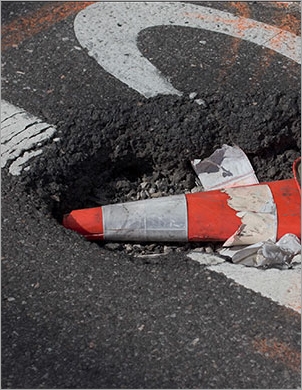Chairman Garodnick, Chairman Rodriguez, members of the joint committee, thank you for inviting me to testify.
My name is Adam Forman. I am a Research Associate at the Center for an Urban Future, a think tank devoted to growing and diversifying the New York City economy, expanding economic opportunity and alleviating obstacles facing low-income and working-class neighborhoods.
Earlier this year, we published a comprehensive report highlighting the challenges associated with New York City’s aging infrastructure. Titled Caution Ahead, our report identified numerous vulnerabilities within the city's utility and transportation infrastructure and building stock.
The city’s transportation infrastructure, in particular, is vital to our economic vitality. Our roads, bridges, tunnels and trains carry millions of New Yorkers to work each morning. When these pathways are closed, clogged and delayed, meetings must be postponed, exchanges missed, transactions stalled, opportunities squandered, and, in some cases, tardy employees fired. In an increasingly interconnected and service-oriented global economy, the success of our city depends on attracting and retaining a talented workforce. If New York’s old and overcrowded subway system, decrepit airport terminals and potholed streets continue to decline, talented individuals will leave the Big Apple, opting for San Francisco, London or Hong Kong instead.
Surveying our transportation infrastructure, it is clear that a number of systems are desperate for investment. More than 160 bridges across the five boroughs were built over a century ago, and in 2012, 47 bridges were deemed both structurally deficient and fracture critical, a designation engineers use for bridges that have little structural redundancy, making them prone to failure and collapse. The subway’s aging signaling system—with 269 miles of mainline signals exceeding their 50-year useful life—slows the movement of trains and requires maintenance workers to build their own replacement parts because manufacturers no longer make them. Finally, at JFK airport, 63 percent of air cargo facilities have been deemed “nonviable” for modern screening, storage and distribution. From 2000 to 2013, cargo at JFK fell by 545,737 tons, the equivalent of 19,101 jobs lost.
Rehabilitating New York City’s aging infrastructure is, of course, an expensive and long-term proposition. Our recent report, Caution Ahead, estimated that it would cost $47.3 billion over the next five years to bring the city (and its authority’s) transportation, utility and building infrastructure to a State of Good Repair. While this is daunting, the benefits of an expansive public works program are considerable. According to a 2009 University of Massachusetts study, every $1 billion invested in roads and bridges creates nearly 15,000 jobs. Importantly, the repair and maintenance of existing infrastructure is found to generate more jobs than new construction.
To facilitate the rehabilitation of infrastructure in the coming years, the city must improve its capital planning process, reduce construction costs and identify new dedicated revenue sources. To more effectively prioritize the city’s capital spending, the Office of Management and Budget and Department of Design and Construction should improve its Asset Information Management System (AIMS) report, a condition assessment of city-owned buildings, parks, bridges and piers. The current inspections are cursory, poorly integrated into the capital planning process and do not include water and sewer assets, public housing, East River bridges or agency vehicles.
To reduce construction delays and cost overruns, the city must avoid inexperienced contractors who fail to live up to their “low bid.” In 2009, Albany authorized cities to pre-qualify public works contractors based on credentials, experience and past performance. City agencies should be more aggressive in implementing pre-qualification lists to ensure that selected contractors are capable of providing quality construction. City officials can also pressure Albany legislators to authorize Design-Build contracts for municipal projects. The current practice of separately bidding out design and construction contracts slows the building process, produces designs that are unsuitable for construction and must often be modified, and blurries accountability for delays, discouraging the use of on-time and on-budget incentives and penalties.
Finally, the city must expand and develop new revenue streams to support its transportation infrastructure. First, it should work with Albany to adopt the Move NY Fair Plan, collecting up to $1.5 billion each year by introducing tolls on East River Bridges.
Second, the city can look to private developers to help fund new infrastructure projects. The second phase of the Second Avenue Subway, for instance, will be a boon to East Harlem real estate. The City could follow London's lead, establishing a Community Infrastructure Levy on each square foot of new construction in the neighborhood. As developers profit from increased investment in public infrastructure, it is only fair that they contribute to this investment. The return on the levy could be divided between the subway extension and the city's affordable housing fund.
Lastly, the city should devote a larger portion of its capital budget to the MTA. In 1989, Mayor Ed Koch allocated 15 percent of the city's total capital budget to the Authority, approximately $950 million, adjusted for inflation. Next year, the city is projected to contribute only $130 million to the MTA, or 2 percent of its capital budget. With the Authority facing a $15 billion shortfall in its upcoming five year capital plan, the city should consider tripling or quadrupling this contribution.
Thank you for considering my testimony. I look forward to your questions.


